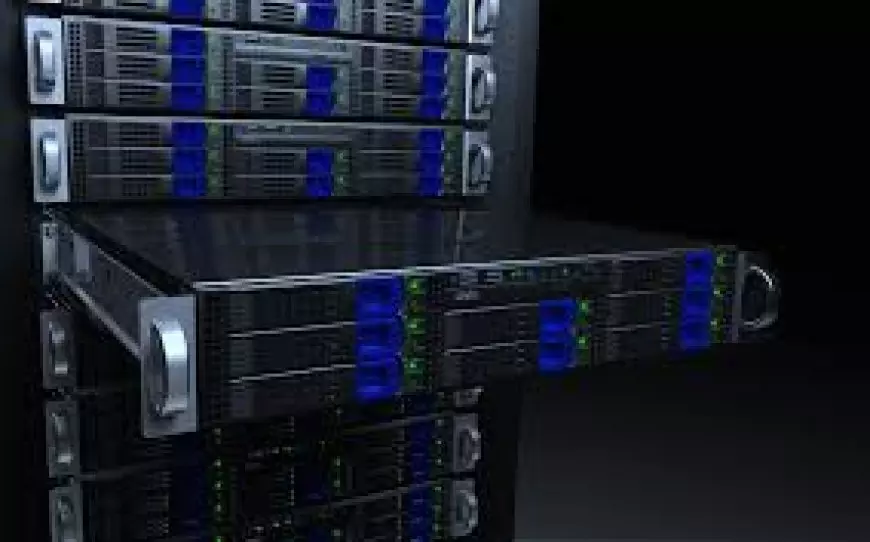A Deep Dive into Rack Server Hardware Components
Rack server, designed for deployment within standardized rack enclosures, have emerged as a cornerstone of modern data centers and server rooms.

Introduction:
In the ever-evolving landscape of information technology, servers' efficient and reliable functioning is paramount. Rack server, designed for deployment within standardized rack enclosures, have emerged as a cornerstone of modern data centers and server rooms. These compact yet powerful machines are engineered to meet the rigorous demands of organizations, providing computational prowess and storage capabilities while optimizing physical space utilization.
In this comprehensive exploration, we embark on a journey into the intricate world of rack server hardware components. From the outer chassis that houses these technological marvels to the intricate circuitry of motherboards and the silicon prowess of CPUs, we will unveil the essential elements that make rack servers the workhorses of contemporary computing environments.
A Deep Dive into Rack Server Hardware Components
A rack server is a type of computer server designed to be mounted in a standard rack enclosure, often used in data centers and server rooms. Rack servers are known for their compact and efficient design, making them ideal for organizations that need to manage multiple servers in a confined space.
Chassis/Enclosure:
The chassis is not just a protective shell; it's designed for efficient airflow and cable management. Proper cable management is vital to maintain a tidy and organized server environment, as tangled cables can impede airflow and cooling.
Motherboard:
The motherboard is where the server's major components connect, making it a central piece of the server's architecture.
It might include features like remote management ports (e.g., IPMI) for out-of-band management and monitoring, which is crucial for server administration in data centers.
Central Processing Unit (CPU):
The choice of CPU(s) impacts server performance significantly. Rack servers often use multi-core processors to handle multiple tasks concurrently.
For specific applications like virtualization or high-performance computing, servers may have multiple CPUs.
Memory (RAM):
RAM size and speed affect the server's ability to handle concurrent processes and workloads. Servers typically use ECC RAM to minimize memory errors, which can be critical in mission-critical applications.
Storage Devices:
Rack servers can have various storage configurations. SSDs and NVMe drives are favored for their speed and reliability.
Storage controllers like RAID cards provide data redundancy and performance improvements, crucial in storage-intensive applications.
Network Interface Cards (NICs):
NIC redundancy ensures network availability. Multiple NICs can be configured for failover and load balancing to improve network reliability and performance.
Power Supply Unit (PSU):
Redundant PSUs are essential for high availability. They not only provide backup but also distribute power efficiently.
Modern servers often feature power-efficient PSUs to reduce energy consumption and operational costs.
Cooling System:
Cooling is critical to preventing overheating, which can lead to hardware failures. Servers use strategically placed fans, airflow channels, and even liquid cooling solutions for efficient heat dissipation.
Management and Monitoring Tools:
Remote management interfaces like IPMI or iDRAC provide extensive control and monitoring capabilities. They enable remote power cycling, system health monitoring, and firmware updates.
Expansion Slots:
Expansion slots offer flexibility to add specialized hardware. For example, a server used for AI/ML tasks might incorporate GPUs, while a storage server may include additional RAID cards.
Front Panel Controls and Indicators:
Front panel indicators provide quick status updates, such as power status, system health, and hard drive activity. They are valuable for on-site troubleshooting.
Operating System and Firmware:
The choice of operating system depends on the server's intended role. Some servers are optimized for Windows environments, while others are designed for Linux or virtualization (e.g., VMware ESXi).
Firmware updates are essential for security and performance enhancements. Manufacturers regularly release updates to address vulnerabilities and improve server functionality.
Optional Hardware:
Depending on the use case, rack servers may include specialized hardware. For example, a server used in a security application might have hardware security modules (HSMs) for encryption and decryption tasks.
The Role of Rack Servers in Edge Computing
The Shift to Edge Computing:
Traditionally, data processing occurred in centralized data centers, often far removed from the data sources themselves. However, the exponential growth of IoT devices, autonomous systems, and the need for ultra-low latency applications has catalyzed the shift toward edge computing.
The Essence of Edge Computing:
Edge computing is characterized by the dissemination of computing resources closer to data-generating devices, reducing latency and bandwidth usage. This distributed architecture empowers applications that demand real-time responses, such as autonomous vehicles, industrial automation, and augmented reality.
The Role of Rack Servers:
Rack servers serve as the backbone of edge computing environments. Here's a closer look at their multifaceted roles:
Proximity to Data Sources:
Rack servers are strategically positioned at the edge, often within remote or edge locations, to process data as close to the source as possible.
This minimizes the time it takes for data to travel to a central data center and back, reducing latency to imperceptible levels.
Processing Power:
Rack servers are equipped with powerful CPUs, memory, and storage capacity, enabling them to perform complex computations and analysis on-site.
This is crucial for applications like real-time analytics, predictive maintenance, and autonomous decision-making.
Data Filtering and Aggregation:
Edge servers pre-process data, filtering out redundant or less critical information before transmitting it to the central data center.
This conserves bandwidth and reduces the computational load on central servers.
Redundancy and Reliability:
Edge environments can be challenging, and often subject to extreme conditions. Rack servers are designed to withstand such conditions, ensuring high availability and reliability.
Redundant power supplies and robust cooling systems are common features.
Scalability:
Edge computing demands scalability to accommodate evolving workloads and data volumes. Rack servers can be easily scaled up or down to meet these dynamic requirements.
Remote Management:
Edge rack servers are equipped with remote management tools, allowing administrators to monitor, update, and troubleshoot servers from a central location.
This minimizes the need for on-site visits, reducing operational costs.
Also read:- Laptop Display Sizes: Finding the Right Fit for You
Conclusion
In the realm of modern computing, where the demands for performance, reliability, and efficiency continue to soar, rack servers stand as stalwart guardians of digital infrastructure. As we conclude our expedition into the intricacies of rack server hardware components, we emerge with a profound appreciation for the role these machines play in powering the digital world.
We have journeyed through the robust chassis that safeguards the server's vital organs, recognizing its role in efficient cable management and airflow optimization. We explored the motherboard, the nerve center connecting all other components, and the CPUs that serve as the server's brain, executing countless instructions with precision.
What's Your Reaction?
































































































